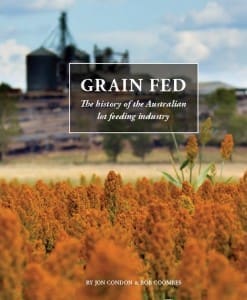With the end-of-year holiday break fast approaching, Beef Central in coming weeks will profile a series of recently-published books that would make ideal Christmas gifts, or for personal consumption among industry stakeholders ….
 ANY beef industry stakeholder who has had even a loose connection with the grainfed beef sector will find the recently-published history of the Australian feedlot industry an absorbing Christmas read.
ANY beef industry stakeholder who has had even a loose connection with the grainfed beef sector will find the recently-published history of the Australian feedlot industry an absorbing Christmas read.
“Grainfed: The history of the Australian feedlot industry” is a 200-page coffee-table style book, richly illustrated with close to 150 historic photographs and documents capturing the essence of the evolution of the grainfed beef sector in Australia.
The book chronicles the 70-year history of lotfeeding, tracing its roots back to a rudimentary feedlot near Tumut in southern NSW in the 1940s; followed by John Stone’s Oakleigh feedlot near Sydney and Swift’s ambitious feedlot near Brisbane a decade later.
“Grainfed” was officially launched at the biennial feedlot industry conference on the Gold Coast in September.
As well as profiling many of the industry’s early pioneers like Dugald Cameron, Robin Hart, Don Bridgeford and Rod Polkinghorne, it explores many little known facts and amusing asides that have added to the industry’s rich tapestry.
Much of the early development in how to feed and manage cattle in a feedyard was ‘fly by the seat of your pants’ stuff, as this early incident, as recounted by pioneer Don Bridgeford, who set up his Mungala feedlot near Warra in 1962 indicates:
“While the use of by-products from the production of grain-based ethanol is much more commonplace among Australian lotfeeders today, especially on the Eastern Darling Downs, it was unheard of when the Bridgefords started experimenting with Wet Distillers Grains (WDGs) in the early 1970s.
A Murgon district cattleman, Rayham Francis, who had earlier served a term as president of the United Graziers Association, had bought a disused pilot ethanol distillery from the NSW DPI. He approached the Bridgefords about installing it adjacent to their feedlot, knowing that cost-effective disposal of the by-product would be essential in trying to make the ethanol project more viable.
The Bridgefords were happy to oblige, given the prospect of a cheap, reliable energy source for their rations.
Don was away on business when he fielded an odd phone call from his wife, Metha at the feedlot, soon after the first batch of WDG arrived .
“I don’t think they’re sick, but the cattle are bumping into things, and falling over,” she said.
It turned out that there had been a miscalculation made in the distillation process, in where to put the decimal point. Instead of an anticipated alcohol content of 0.5 percent, the Wet Distillers Grains in fact contained 5 percent alcohol, producing predictable, if not comical results. Fortunately the worst the cattle suffered was a hangover.”
“Grainfed: the history of the Australian feedlot industry” was written by Beef Central publisher Jon Condon, with support from former ALFA executive director, Bob Coombs. Both have worked closely with the Australian feedlot industry for the past 35 years.
With many of the industry’s early pioneers now getting on in years, it became increasingly important to capture their memories and recollections of the pioneering era for posterity.
Many early presidents, including Queensland’s Don Bridgeford and Victoria’s John Richardson, both now well into their 80s, showed remarkable powers of recall, given that their industry service ended more than 40 years ago. Lotfeeders, it seems, were viewed with some suspicion by the grassfed sector, as well as graingrowers, in the early years.
The book also discusses at length, many of the major industry contributions for which the grainfed sector can take credit, including the advent of the Meat Standards Australia grading system, and on-farm quality assurance.
“The history has been almost thirty years in the making,” said Robin Hart, former president of the Australian Lot Feeders Association, who collaborated closely with the authors on the book’s development.
“While the gathering and collation of the industry’s history from countless sources has been an arduous task, it has led to an authoritative document that finally details on paper the anecdotes, images and background of a history that might otherwise have largely been lost due to the passage of time.”
Click on the Youtube link below to view a video interview with Robin Hart about the book
Purchase in time for Christmas
The hardcover book, “Grainfed: A History of the Australian feedlot industry,” comes in two versions, a ‘standard’ edition priced at $60 plus postage, and a gift-boxed and ribbon enclosed ‘special edition’ priced at $80 plus postage. Both would make an ideal Christmas gift.
There is still plenty of time to make an online purchase in time to receive your copy, or copies by December 25. Click here to lodge an order and make advance payment.
Next Week: “World on a Plate” captures the eventful history and colourful characters associated with the Australian red meat processing industry – a must read for anybody who’s ever had a connection with processing.



HAVE YOUR SAY